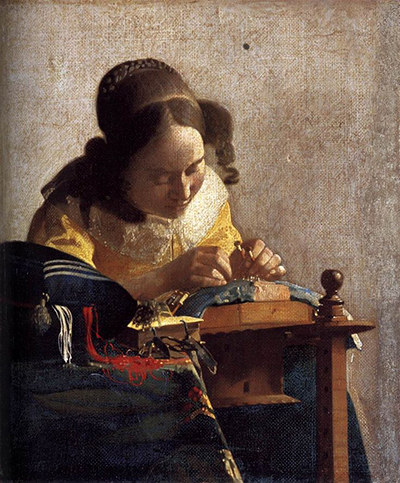The artist Johannes Vermeer painted The Lacemaker c. 1669 – 1670.
Vermeer’s early works include religious and mythical subjects but in the late 1650’s, he changed his subject matter in parallel with the works of his contemporaries.
In the less religious, more materialistic world of post-Renaissance painting, the majority of artists’ patrons were of the middle classes. These patrons of art favoured images of the ordinary and everyday world, landscapes, house interiors and domestic scenes.
While many of Vermeer’s contemporaries painted “still lifes”, that is, depictions of household objects and items of food, Vermeer chose to paint human activity. The majority of his later paintings involve people talking, reading, playing music and working, for example, The Milkmaid, (1658).
Vermeer was a Baroque painter, images typified by extravagant, flowing lines while Renaissance art involved stiff, geometric features. However, The Lacemaker does retain a number of sixteenth-century characteristics, a quality that adds an interesting tension to the painting. The rigid lines of the loom and worktop, the pins and the stiffened threads, are in contrast to the soft curvature of the woman’s hands, her face and flowing hair.
The objects in front of the woman show Vermeer’s knowledge of perspective, that is, reducing them in size as they recede from the foreground. This creates a sense of space, both in front of the viewer and that of the painting’s subject, the lace-making woman.
This perspective adds realism to the solid rotundity of the woman, who dominates the painting in the same way as a Madonna in a religious painting. Her hood of hair forms a halo around her head, and her face is almost spiritual in the rapt concentration with which she pays attention to her work. Most significant, the painting makes space for the viewer, who can imagine reaching into it and touching the work materials.
Spinning cloth and lace were age-old occupations, humble work undertaken mainly by women. New seventeenth-century theories about planetary motion had made the artist aware of the importance of “the spin”, and of how the sun, the earth and other planets acted upon another.
A thread of gravity holds the earth to the sun. Yet, an unseen force, nature or God, controls these seemingly arbitrary powers. Remove that control and Earth and everything upon it will become as limp and lifeless as the skeins of red threads falling upon the blue cushion, and as the curls of loose hair falling from the woman’s otherwise rigid coiffure. The painting pays homage to the woman and the dignity of her labour.
The viewer can almost hear the threads whispering together, and see the length of lace growing as she spins her bobbins over the loom. The lace-making apparatus, the bobbins and threads, represent the woman’s entire universe. The blank wall, the “nothingness” behind her, heightens this sense. Judging by the shadow cast on the wall by her figure, and the nuances of light and shade on her hands and face, Vermeer understood light as a physical entity that originated from sources outside of a subject. This rendering is in contrast to the way that earlier painters of religious scenes depicted light as an inner glow emanating from a spiritual subject.
The lacemaker is dressed in yellow and her cushion, tablecloth and work materials are blue, a visual trope that has become Vermeer’s “trademark”. Scholars and art historians have discoursed at length as to why the artist favoured this combination of ultramarine (blue) and lead-tin yellow. One theory is that Vermeer, who kept an inn to support his large family, could only paint in his spare time. Because of this, he sought to bring outdoor sunshine or yellow, and daylight or blue, into his painted interiors. In The Lacemaker, the outside world is also present in the red flowers embroidered on the blue tablecloth. Red tones continued in Girl with a Red Hat.
In summary, The Lacemaker is a parable on the importance of man’s industry in an arbitrary universe. It is also a poetic convergence of mathematics and optical theory, of light and colour, of shade and nuance, of simplicity, elegance and beauty.




